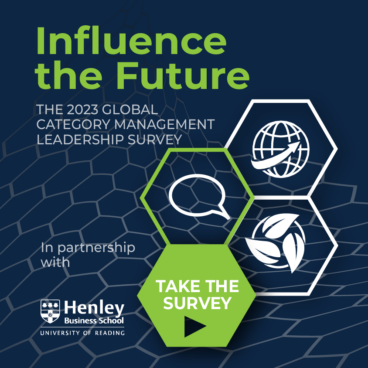
Podcast
Re-Organising Procurement Using Category Management | Jon Hughes
Interview with procurement and supply chain expert Jon Hughes.
By Mark Webb |

Jon Hughes
Profile
35 years international business experience specialising in procurement change management.
Previous employment:
General Motors, British Steel, NWRMC, Co-Founder & Chairman of ADR Purchasing Consultants, Innovation Director for QP Group.
Education:
BA (Hons) and MA in Organisational Psychology, Cambridge University.
CIPS Fellow and holder of their Swinbank Award for Procurement Innovation.
Former Visiting Fellow at Birmingham University and the Vlerick Leuven Business School.
Role in FP: Chairman
Mark Webb, Managing Director, talks to Jon Hughes
In episode 2 of our 5-part podcast series on category management in procurement, Jon Hughes and Mark Webb move from the 80s into the 90s and discuss the challenges that came with getting the support and endorsement of senior management, and the cultural and interpersonal side of welding teams together.
Transcript
00:00:00:02 – 00:00:25:19
Mark Webb
Because at the moment, the way most people that we work with certainly view is that it’s a combination of things. Yes, there’s the facts of the hard sort of technical aspects of it, but there’s also the engagement of the business, as you say, understanding of people, governance around the categories, working out those things. The thing that really drive change, at the start was that combination of the sort of technical procurement, you know, with supply market analysis, as you say, cost analysis, and then the change piece was in there from the start, or did that evolve?
00:00:30:09 – 00:00:48:11
Jon Hughes
I think at the start the focus was quite narrow and we used quite a simple concept, that we called tactical control and strategic control. What we meant by that was that if we lined up all the categories of expenditure, some of those categories were not strategic in any shape or form. They were fairly tactical, fairly operational categories.
So we developed a very simple idea. What we need is a tactical plan, a tactical control plan for those simple areas of expenditure so that we could actually manage them in a more efficient manner. Very simple. Then we introduced the idea of strategic control. There were clearly categories that had much more impact and importance to the organization and into that we introduced the concept of the source plan.
So, we actually worked with clients to produce source plans in those categories in expenditure to obtain what we called strategic control, to actually put our arms right around that expenditure in whatever geographical cut it was going to be. And again, coming back to the marketing area, I looked very closely at the presentation that marketing people were making on brand plans, annual brand plans as part of the overall strategic planning process.
So we basically took the same idea again and said, Well, let’s have source plans as part of the overall strategic process, and some of the early source plans that were created by some of the early procurement leaders were quite honestly revolutionary compared to what we’d seen before. And we were, again, very lucky, working with top-quality people producing source plans that really resonated with business people about the things that really mattered to them.
We started to be pushing on the door, quite honestly. You know, I think that so early, the line of thinking wasn’t mega sophisticated. No, it wasn’t. But it certainly gave a sense of vision, a sense of, you know, we can simply model out one year, three years, five years. We said within the source plan that there had to be a clear framework and people had to make sure that when they did the presentations, they followed that source planning structure to give clarity on a number of key headings.
Yeah, it was all pretty revolutionary stuff. I mean, some of the procurement people just didn’t get it. It’s like, you know, you could actually use source planning as a test of professional competence. You know, if you give someone a set of data and say, okay, systematize that to come up with a forward one, three, five year plan, if you can’t do it, the chances are you aren’t going to succeed. You need people who can intellectually get their minds around it.
And then I think this broadened out particularly into the globalization piece to really say, look, how do we do these source plans? Some of these will be very local, and some needed to be regional. And I can remember, in particular, doing some work in Europe and trying to get all the European procurement teams to come together.
The cultural and interpersonal factors, all the problems of welding a team together, were a hell of a challenge. And I still think the cultural, engagement, stakeholder, interpersonal piece is more difficult than the purely analytical side.
00:03:21:23 – 00:03:29:12
Mark Webb
Yeah, absolutely. So, what were those? Those early clients? I don’t want to name names, but typically which sectors were they in?
00:03:29:16 – 00:03:54:14
Jon Hughes
I don’t mind naming names, many of them have been referenced in articles I’ve done over the years. I mean, an early one was Reckitt & Colman, true blue company would be taken over by Reckitt Benckiser. That was a global initiative. We did a lot of work with Standard Chartered Bank. They went through a terrible financial crisis back in the 1980s and largely based out in Hong Kong that gave us the first opportunity to actually work right across Asia and through Eastern Africa.
00:03:54:15 – 00:04:36:27
Jon Hughes
Did a huge amount of work with SmithKline Beecham, who obviously merged eventually into GSK. There were a couple of people in there who were extreme enthusiasts of everything we were doing, some of that went on also to move into management consultancy, most notably Robin Cammish, There is a strong GSK community.
Also FMCG, banking, financial services, pharmaceuticals. But also we did some work, you know, in really tough sectors, such as a big assignment for Lawson Marden, a major packaging company. Source plans on carton board, source plans on ink. You know, real dirt beneath the fingertips type of work. Did a similar piece for a building products company Marley. People may have heard of Marley tiles, again a very low margin business.
00:04:36:27 – 00:05:03:21
Jon Hughes
So I think we basically had a complete range really here, Mark. We had the the low margin businesses for whom financial contribution was going to be absolutely right at the heart of it, right through to quite high margin businesses, who have bigger global issues that they wanted to address. So FMCG as well as some of the more simple businesses.
The common denominator running through all of them was that they had to deal with the central challenge of being multi-locational, lots of sites, lots of people, lots of functions, lots of challenges of communication, lots of challenges of engagement, how on earth to weld together a very disparate group of people so they would buy in to a unified, codified way of work. That’s probably the number one common denominator. And as we went through the evolution of Catman from the analytical side into the sourcing strategy side, the source planning side, the whole area of governance came onto the table as a major, major, major theme.
00:05:37:03 – 00:06:10:17
Jon Hughes
And we realized that we couldn’t just allow the management of the category management process to just remain very informal. We had to have more structured process without it becoming a bureaucracy. I think governance and the whole area of prioritizing categories, category planning, category sequencing, review steps, review stages, stakeholder boards, presentations to these groups, formal sign-offs, monitoring delivery, performance measurements.
That whole piece is probably the phase that really started to get going in the 1990s. And of course I think in the last ten or 15 years is still developing. It still remains quite a big challenge because you can only get successful governance if you’ve actually got a decent level of senior management support and endorsements, as well as building the stakeholder management piece, I think getting the buy-in and doing the presentations to the absolute top leadership teams just becomes so vital. And if you can’t get that, ultimately it becomes the barrier that stops the progress.
00:06:41:10 – 00:06:49:04
Mark Webb
I was going to say there were some examples where that top level support piece wasn’t put in place and certain programs maybe weren’t as successful as others.
00:06:49:04 – 00:07:18:09
Jon Hughes
I think you can make quite significant progress with a program that is purely a functional initiative, run by procurement, led by procurement, delivered by procurement, for procurement. At the end of the day, that remains a functional activity. The challenge is how on earth to get there, move it from that to being seen as genuinely supporting a business process, a business activity, that is being owned by and led by the top management of the business.
Okay, The delivery is still being done or being led by a lot of the procurement people, but it’s got to be a business led activity. Now for me, I think when we looked at the expenditure map in so many organizations, you and I both know that the amount of expenditure that is actually under the control of a procurement function is invariably the minority.
00:07:38:23 – 00:07:59:17
Jon Hughes
So if you’re going to open the door to the majority of expenditure and therefore the majority of the supplier network, if you can’t get to that business owned activity, that sense of the company / the business, actually “getting it”, then you’ve hit the hard ceiling. Or there is a glass ceiling that somehow you’ve got to break through. But you can’t break through it like a battering ram.
00:07:59:17 – 00:08:22:20
Jon Hughes
You know, my view was you always have to locate major supporters of what you’re trying to do, whatever they may be. They could be in manufacturing, they could be in marketing, they could be in R&D, they could be in finance. they could even be in human resources. You’ve got to find people, I think, who are saying, this is worth supporting and I will work with you to get it elevated to become a genuine business wide competence. That’s a massive change.
00:08:22:20 – 00:08:25:27
Mark Webb
Yeah. And how do you get that over with certain organizations or how did you? The complexity that some people perceive to achieve this. You know, I heard somebody say recently that they could see that there was some potential benefit. But, you know, is there really a payback from all of the rerouting of current ways of working, certainly in a very project orientated organization.
I just wondered if you’d have any sort of senior people that would look at it and sort of challenge the business case for doing it.
00:08:51:27 – 00:09:12:20
Jon Hughes
I think even now, procurement gets a bad press in a lot of organizations, sometimes with reason. I think there are still a lot of procurement people who see themselves as at war with the organization, you know, that they’re trying to progress their model of change, that the sort of persuasion that they’re trying to use inside the business is just not appropriate. It’s just not going to work.
00:09:12:20 – 00:09:35:21
Jon Hughes
So if we’re looking at two or three of the levers that can really make a difference, the first one without any doubt, is results. You can’t convince senior management just by talking about it. You have to get results. Now, again, I think if I look back on some of the organizations where it succeeded, they managed to get good results onto the table on the right side of the time horizon.
00:09:35:26 – 00:10:01:06
Jon Hughes
It hasn’t all been promised in the future. They’ve had a focused approach and therefore they’ve prioritized expenditure. Again, you and I are passionate believers in this, and you have to have category planning to achieve this. You can’t just move from, you know, a fairly sort of diffuse process into the end goal you’re trying to achieve. You can’t achieve that overnight. It takes a number of years to do it, so you have to have milestones.
00:10:01:06 – 00:10:20:03
Jon Hughes
So on any time horizon, I think in any organization that’s genuinely trying to move category management forward, you must have results inside a 12 month time horizon. You just must. If you’ve decent results inside 12 months and you’re starting to get some success stories, you can move into the sort of two year, three year time horizon.
00:10:20:03 – 00:10:38:26
Jon Hughes
If you’re still getting good results over the next couple of years, then you get to a stage where you can genuinely make step change and where lots of other things start to sort of coalesce and you can start to move into really quite radical areas. But you have to keep that focus. You must keep the prioritization. I’ve found this over the years, not just in procurement.
00:10:38:26 – 00:11:02:04
Jon Hughes
I think many business leaders struggle to get enough success stories onto the table so that they can obtain the resources they need, the budget they need, changes of staff that they need, the technology that they need to really move forward. So if you’re not careful, it can default into fairly tactical delivery, that just doesn’t grab the attention of senior people.
00:11:02:04 – 00:11:23:13
Jon Hughes
So really getting that prioritization, getting that roadmap, getting that sense of exactly where you’re going to be moving over a number of years, is a massive lever. And then putting that together into some sort of business case or some sort of business plan which is capable of being audited and validated. Again, a phrase I always used was, “Don’t mark your own homework.”
00:11:23:13 – 00:11:58:08
Jon Hughes
It’s no good procurement saying, it’s doing a fantastic job. What matters is always do the key functions, the key business communities in the organization say, I was really sceptical at the start, but procurement is delivering. I have seen benefits to my part of the business. ABC, X-Y-Z. You’ve got to get to the stage, I think, where you’ve got people who are monitoring and reviewing what procurement is doing, just like any other business discipline, and they’re saying that it is succeeding. Maybe not everything is succeeding, but if you’ve got to a critical mass and you’re now going to extend this further and deeper into the whole organization.

About Mark Webb
Managing Director
22 years procurement experience in line management
and consulting roles.
Previous employment: Price Waterhouse, Mobil Oil and QP Group
Education: BSc in Management Science and MSc in Business by Research, Aston University
CIPS: member
Other Podcasts and Blogs

Podcast
Rethinking Procurement in 2023 | Jon Hughes Interview
13/06/2023
Listen

Podcast
Embedding Category Management And The Future | Jon Hughes
14/06/2023
Listen

Case study
Andrew Cubitt interview – Category management is a top procurement priority for wider spend efficiency at HS2
08/02/2024
Read More
